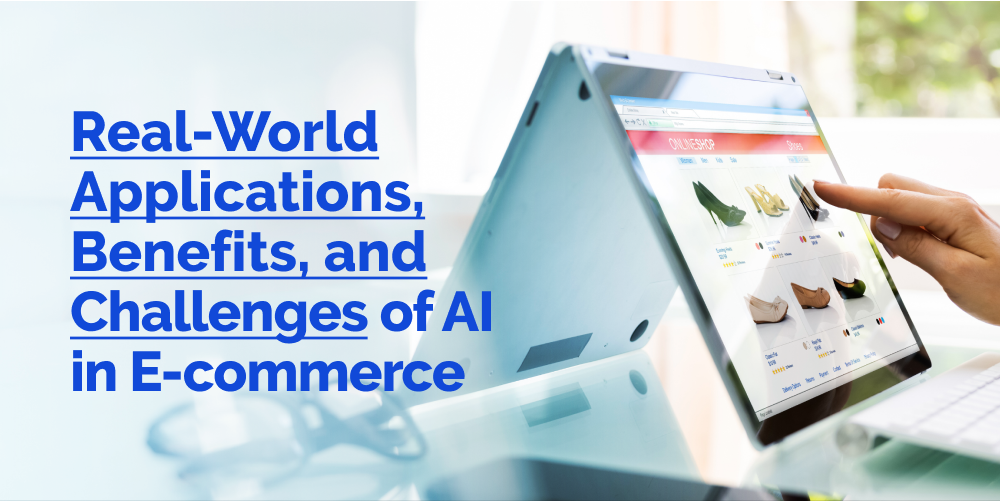Ecommerce Development, zBlog
Unlocking the Power of AI in eCommerce: Real-World Applications, Benefits and Lingering Hurdles
atif | Updated: January 22, 2024

AI in eCommerce: Introduction
Artificial intelligence is rapidly transforming the e-commerce landscape by providing retailers with previously impossible abilities to personalize, predict, and fulfill customer needs. Early AI adoption has become a competitive necessity for digitally-native brands to keep pace with leaders harnessing their capabilities.
Let’s explore some of the most impactful applications of AI in eCommerce across planning, marketing, pricing, and operations – as well as their tangible business benefits using real-world examples:
AI-Driven Demand Sensing and Inventory Optimization

Growing DTC brands often need help balancing limited working capital and warehouse space against volatile consumer demand swings. AI-powered demand sensing tools provided by vendors like Intelliflux now allow young brands to forecast sales and optimize inventories with far greater precision.
For example, apparel retailer M.M.LaFleur saw a 30% increase in demand prediction accuracy by leveraging Intelliflux’s Machine Learning algorithms to inform production schedules and inventory buys. This significantly cut down on costly overproduction and lost sales from stockouts.
Algorithmic Product Recommendations

Through robust historical datasets on past purchases and browsing behavior, AI recommendation engines serve up hyper-relevant products for each anonymous website visitor to boost conversions.
Cosmetics e-tailer Sephora saw a 15-30% increase in order values and cart additions when leveraging Artificial Intelligence to personalize product suggestions for online shoppers based on skin type, budget, previous buys, and rating data.
Personalized Emails and Predictive Churn Analysis

AI-powered email marketing automation takes real-time insights into customer activity and translates those signals into timely, personalized messaging. Apparel maker Everlane increased purchase frequency by 7X through hyper-targeted emails highlighting newly available products that match customers’ unique style preferences.
Additionally, AI analyzes factors predicting customer churn to trigger proactive retention campaigns preventing attrition. Beauty retailer Glossier leverages AI and 20% higher retention rates year-over-year through churn analysis and incentives for at-risk subscribers.
AI-Optimized Pricing Strategies

Machine learning algorithms constantly analyze demand signals, competitor data, purchase trends, and inventory levels to optimize pricing for margin and volume tradeoffs.
Furniture brand Article saw a 12% gross margin increase in its first year of leveraging AI pricing algorithms while maintaining double-digit sales growth month-over-month.
Automated Order Fulfillment and Supply Chain Tracking

When it comes to applications of AI in eCommerce, robotics and computer vision are helping brands scale order fulfillment faster without ballooning labor costs. Apparel maker ThredUp built an automated warehouse handling over 100,000 used clothing items daily for resale via AI-guided robotics. This allowed a 75% fulfillment cost reduction even as order volume grew 4X over two years.
Additionally, AI powers real-time shipment tracking and dynamic delivery date estimates popularized by Amazon. Pet goods supplier Chewy provides anxious customers with constant order updates and exception management via their mobile app.
Overcoming AI Adoption Hurdles with a Crawl-Walk-Run Roadmap

While application of AI in eCommerce unlocks tremendous potential, most brands cite lingering barriers around infrastructure requirements, data strategy, and internal readiness limiting faster enterprise adoption:
- Prioritizing Data Pipelines and Analytics Maturity First
Since AI relies on clean, aggregated data across customer touchpoints, brands need strong data foundations before deploying machine learning to avoid low-quality model outputs. eCommerce development leaders suggest solid customer data integration as a crawl phase priority. - Proving AI Value Through Limited Pilots Before Company-Wide Initiatives
Gartner research found just 15% of recent AI pilot projects successfully expanded into scaled implementations afterward due to poor alignment around use cases. Strategic walk-phase pilots with executive sponsorship prevent this. - Committing Resources to Upskill Teams on AI Best Practices
The run phase of successful AI adoption requires investment into gaining internal capabilities. Brands that proactively train merchandising, marketing, and tech teams to properly utilize AI tools outperform.
The Road Ahead: AI in eCommerce Battleground

Industry analysts predict AI could unlock over $2 trillion in incremental value across retail and consumer goods alone over the next decade. Advancements in machine learning solutions via AWS, Google Cloud, and startups like Algonomy continue lowering barriers to leverage these innovations.
But while the AI gold rush offers rich opportunities, the core principles of focusing on the customer, iterating around their needs through constant testing and building a data-driven ecosystem still separate sustainable market leaders from laggard followers in eCommerce. By laying the right foundations today and adopting AI judiciously over time, digitally-native brands can unlock disproportionate, lasting advantages.
Conclusion
In the evolving landscape of eCommerce, harnessing the power of artificial intelligence has become a strategic imperative for brands aiming to stay ahead. From demand sensing to personalized marketing, AI offers tangible benefits in optimizing operations, enhancing customer experiences, and driving revenue growth. However, the journey towards widespread AI adoption comes with its challenges, including infrastructure requirements and the need for a robust data strategy. As brands navigate this transformative road, strategic partnerships with technology experts like Trantor can provide the guidance and solutions needed to overcome hurdles and unlock the full potential of AI in eCommerce.




